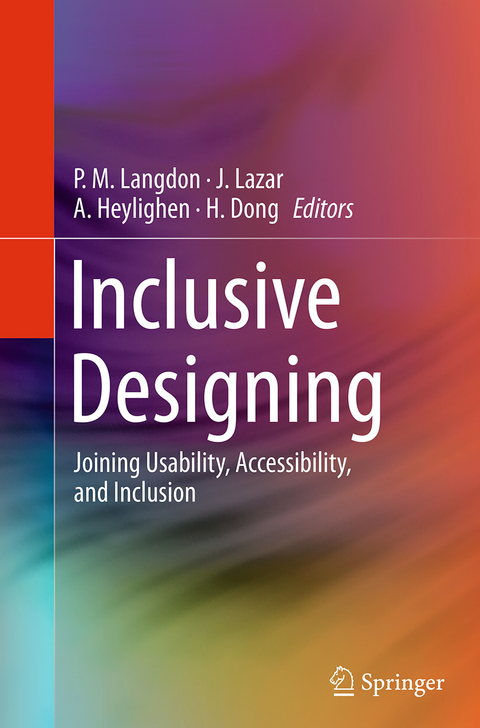
Inclusive Designing
Springer International Publishing (Verlag)
978-3-319-35738-6 (ISBN)
Dr Patrick Langdon is an experimental psychologist who has contributed to cognitive science, artificial intelligence, robotics and psychophysics. Now at the Cambridge University Engineering Design Centre his most recent research has been in Inclusive User Centred Design, interaction design, prior experience, and multimodal interface profiling from cognitive modelling. Dr Langdon was primary author and co-investigator of the successful EPSRC EQUAL "i~design 3" consortium project; "Extending Active Living Through More Effective Inclusive Design" (2006-2011), which he also managed. He was invited to join phase 2 of the (EPSRC/DST) India-UK Advanced Technology Centre, a centre of excellence for next generation network systems and services, where, with a team of recruited research associates he has built on recent success developing UI technology to support adaptive user interfaces that are accessible to the wider range of users, having impact in both the UK and India. Pat Langdon is the Author and Co-PI of five new EPSRC and Industry funded projects, all concerned with user centred design for new Human Machine Interfaces, in the application areas of Automotive, Aerospace and wireless communications in emergencies. Jonathan Lazar is a professor of computer and information sciences, director of the undergraduate program in information systems, and founder and director of the Universal Usability Laboratory, all at Towson University. His research focuses on understanding how people with disabilities interact with technologies, how improved interface design can change the quality of life for people with disabilities, and how human-computer interaction and public policy influence each other. During the 2012-2013 academic year, Dr. Lazar was the Shutzer Fellow at the Radcliffe Institute for Advanced Study at Harvard University, researching the relationship between web-based interfaces that are inaccessible to people with disabilities, and how those inaccessible interfaces lead to forms of discrimination that are illegal under US law. Lazar has published more than 120 refereed articles in journals, books, and conference proceedings. He has also authored three books and edited three, including Research Methods in Human-Computer Interaction (Wiley, 2010), Universal Usability: Designing Computer Interfaces for Diverse User Populations (Wiley, 2007), and Web Usability: A User-Centered Design Approach (Addison Wesley, 2006). He was awarded a 2011 University System of Maryland Board of Regents Faculty Award for Public Service, a 2010 Dr. Jacob Bolotin Award from the National Federation of the Blind for working towards achieving the full integration of the blind into society on a basis of equality, and a 2009 Innovator of the Year Award from the Maryland Daily Record for his work on improving the accessibility of web-based security features. He currently serves as chair of public policy for ACM SIGCHI (the Association for Computing Machinery Special Interest Group on Computer-Human Interaction). Ann Heylighen is a professor in the Research[x]Design group of the Department of Architecture at the University of Leuven (KU Leuven). Her main research interests are situated at the interface of design studies and social sciences. She is particularly interested in issues concerning inclusivity and is currently leading several research projects on dialogues between architectural design and disability. Ann was awarded several research grants, including a Starting Grant and Proof-of-Concept Grant of the European Research Council. She is a member of the editorial board of CoDesign, and a member of the KU Leuven Research Council. Ann studied engineering/architecture at KU Leuven and ETH Zürich, and completed a PhD at KU Leuven. After conducting postdoctoral research at Harvard University and the University of California-Berkel
Preface.- Part I Measuring Product Demand and Peoples' Capabilities.- An HCI Survey on Elderly Users in India.- User Capabilities vs. Device Task Demands in a Tape Dispenser Product for Persons with Limited Dexterity.- Part II Designing Cognitive Interaction with Emerging Technologies.- Three Scanning Methods for Text Cursor Manipulation.- A Combinatory Approach to Assessing User Performance of Digital Interfaces.- How Interface Adaptation for Physical Impairment Can Help Able Bodied Users in Situational Impairment.- Gender Issues in ICT Adoption: A Literature Review.- Blind and Deaf Consumer Preferences for Android and iOS Smartphones.
| Erscheinungsdatum | 16.09.2016 |
|---|---|
| Zusatzinfo | XVI, 282 p. 47 illus., 32 illus. in color. |
| Verlagsort | Cham |
| Sprache | englisch |
| Maße | 155 x 235 mm |
| Themenwelt | Informatik ► Software Entwicklung ► User Interfaces (HCI) |
| Informatik ► Weitere Themen ► CAD-Programme | |
| Technik ► Maschinenbau | |
| Schlagworte | Assistive Technology • Computer-Aided Design (CAD) • Computer-Aided Engineering (CAD, CAE) and Design • CWUAAT '14 • Engineering • Engineering design • Human-Computer interaction • inclusive design • Interaction Design • Rehabilitation Engineering • technical design • Universal Access • User interface design and usability |
| ISBN-10 | 3-319-35738-7 / 3319357387 |
| ISBN-13 | 978-3-319-35738-6 / 9783319357386 |
| Zustand | Neuware |
| Haben Sie eine Frage zum Produkt? |
aus dem Bereich


